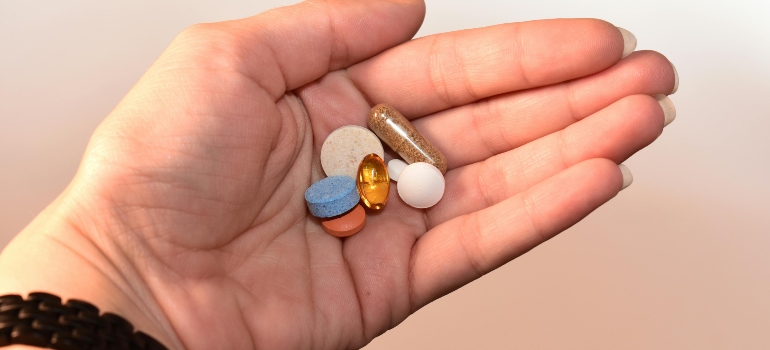Managing Pain Relief with Tramadol: What You Need to Know
Managing pain effectively is crucial for maintaining quality of life, and Tramadol is one medication that’s often prescribed for this purpose. Tramadol is a type of pain medication that belongs to the class of drugs known as opioid analgesics. It’s commonly used to treat moderate to severe pain. However, like any medication, it comes with its own set of potential side effects and guidelines for use. In this blog post, we’ll break down everything you need to know about managing pain relief with Tramadol. We’ll cover its uses, potential side effects, recommended dosage guidelines, and important precautions to keep in mind.
Jump to Section
What is Tramadol?
Tramadol is a type of pain medication that belongs to the class of drugs known as opioid analgesics. It’s prescribed to treat moderate to severe pain, often after surgeries, injuries, or for chronic conditions like arthritis. It works by altering the way the brain perceives pain signals from the nerves in the body. It does this by binding to opioid receptors in the brain and spinal cord. These receptors are like switches that control the transmission of pain signals. When Tramadol binds to these receptors, it blocks the transmission of pain signals and also increases the levels of certain neurotransmitters like serotonin and norepinephrine. These neurotransmitters help to further reduce the sensation of pain.

What makes Tramadol unique compared to other pain relief medications is its dual mechanism of action. Unlike traditional opioids such as morphine or codeine, which primarily work by binding to mu-opioid receptors, Tramadol also affects serotonin and norepinephrine levels in the brain. This means that Tramadol not only provides pain relief but can also have additional effects on mood and emotional well-being.
Additionally, Tramadol has a lower risk of respiratory depression compared to other opioids, meaning it’s less likely to cause breathing difficulties, especially when used at recommended doses. However, it’s still important to use it as directed by your healthcare provider to minimize the risk of side effects and dependence.
What is Tramadol Used For?
Tramadol is primarily prescribed to treat moderate to severe pain caused by various conditions such as injuries, surgeries, or chronic conditions like arthritis. It’s commonly used when other pain medications like acetaminophen or nonsteroidal anti-inflammatory drugs (NSAIDs) aren’t providing enough relief.
However, beyond its primary indications, Tramadol is sometimes used off-label for other conditions. Off-label means using a medication for a purpose not approved by regulatory authorities like the FDA. Some off-label uses of Tramadol include treating neuropathic pain (nerve pain), fibromyalgia, and restless leg syndrome.
While managing pain relief with Tramadol for these off-label conditions can be successful, its effectiveness still varies from person to person. For example, some individuals with neuropathic pain may find significant relief with Tramadol, while others may not experience the same benefits. It’s important for healthcare providers to carefully consider the potential risks and benefits before prescribing Tramadol off-label.
Overall, Tramadol is a versatile medication in pain management, but it also has its limits. While it can provide relief for a wide range of pain conditions, it may not be suitable for everyone, especially those with a history of substance abuse or certain medical conditions.
Side Effects of Tramadol
Tramadol can cause several common side effects, although not everyone will experience them. These side effects happen in 1 in 10 people, and they include:
- Nausea and vomiting: Some people may feel sick to their stomach or vomit after taking Tramadol.
- Dizziness or lightheadedness: Tramadol can make some people feel dizzy or lightheaded, which may increase the risk of falls, especially in older adults.
- Drowsiness: Tramadol can cause drowsiness or sleepiness, making it important to avoid activities that require alertness, such as driving or operating machinery, until you know how the medication affects you.
- Constipation: Tramadol can slow down digestion and lead to constipation in some people. Drinking plenty of fluids and eating fiber-rich foods can help alleviate this side effect.
- Headache: Some people may experience headaches while managing pain relief with Tramadol.

Serious Side Effects
While most people tolerate Tramadol well, there are some serious side effects. If you experience any of these symptoms, seek medical help right away. These include:
- Severe allergic reactions: Some people may have an allergic reaction to Tramadol, which can cause symptoms such as hives, difficulty breathing, or swelling of the face, lips, tongue, or throat.
- Seizures: Tramadol can lower the seizure threshold in some individuals, increasing the risk of seizures. This risk is higher in people with a history of seizures or epilepsy.
- Serotonin syndrome: Tramadol can increase serotonin levels in the brain, leading to a condition called serotonin syndrome. Symptoms of serotonin syndrome include agitation, hallucinations, fast heart rate, fever, sweating, shivering, muscle stiffness, twitching, loss of coordination, nausea, vomiting, or diarrhea.
- Respiratory depression: Tramadol can slow down breathing, especially when taken in high doses or combined with other medications that depress the respiratory system, such as other opioids or benzodiazepines. Symptoms of respiratory depression include shallow or slow breathing, difficulty breathing, or being unable to wake up.
- Increased intracranial pressure: Tramadol may increase the pressure inside the skull, especially in people with head injuries, brain tumors, or other conditions affecting the brain. Symptoms of increased intracranial pressure include severe headache, blurred vision, confusion, nausea, vomiting, and seizures.
Long-term Effects of Tramadol Use
One significant concern with long-term Tramadol use is the risk of dependence and addiction. Tramadol affects the brain’s reward system, leading to feelings of pleasure and euphoria. Over time, some individuals may develop a tolerance to Tramadol, requiring higher doses to achieve the same pain relief. This can increase the risk of addiction and withdrawal symptoms that require specialized prescription drug addiction treatment.
Another long-term effect of Tramadol use is the potential for respiratory depression, where breathing becomes dangerously slow or shallow. While Tramadol is considered to have a lower risk of respiratory depression compared to other opioids, it can still occur, especially at higher doses or when combined with other medications that depress the respiratory system.

Additionally, long-term use of Tramadol can lead to gastrointestinal issues such as constipation, which may become chronic if not managed properly. Other potential side effects of long-term Tramadol use may include dizziness, drowsiness, and cognitive impairment.
Warnings and Precautions
Tramadol is a powerful pain reliever, but it’s not suitable for everyone and can interact harmfully with other medications and substances. Here are some important contraindications and potential interactions to be aware of:
- Alcohol: Combining Tramadol with alcohol increases the risk of serious side effects like respiratory depression (slowed breathing), drowsiness, and impaired motor control.
- Other CNS Depressants: Tramadol should not be used with other central nervous system (CNS) depressants unless specifically directed by a doctor. CNS depressants include medications such as benzodiazepines (like diazepam), sleeping pills, other opioids, or drugs for anxiety.
- MAO Inhibitors: If you are taking or have taken monoamine oxidase inhibitors (MAOIs) within the last 14 days, you should avoid Tramadol. MAOIs are used primarily to treat depression and include drugs like selegiline and phenelzine. Mixing MAOIs with Tramadol can lead to a dangerous increase in serotonin levels.
- Selective Serotonin Reuptake Inhibitors (SSRIs) and Serotonin-Norepinephrine Reuptake Inhibitors (SNRIs): These are classes of drugs often prescribed for depression or anxiety. Examples include fluoxetine (Prozac) and venlafaxine (Effexor). These medications can interact with Tramadol, increasing the risk of serotonin syndrome.
- Medications that Lower the Seizure Threshold: Tramadol can increase the risk of seizures, especially in high doses or when combined with other drugs that also lower the seizure threshold. Examples of such drugs include antipsychotic medications.
If you’re worried you won’t be able to stop consuming alcohol or other substances during Tramadol treatment, consult a healthcare provider or seek help from drug and alcohol treatment centers in Pennsylvania.
Risk of Addiction When Managing Pain Relief with Tramadol
Tramadol, like other opioids, carries a significant risk of addiction, abuse, and misuse, which can lead to overdose and death. This risk can occur even at recommended doses and if you use the medication as prescribed.
Addiction is a chronic, relapsing disorder characterized by compulsive drug seeking and use despite harmful consequences. People can develop an addiction to Tramadol because it activates the brain’s reward centers, potentially leading to euphoric feelings, which might encourage repeated use.

Abuse of Tramadol involves taking the medication in a manner or dose other than prescribed or taking it without a prescription. This includes taking Tramadol to achieve a high, using it more frequently, or using it in a different way than prescribed, such as crushing the pills to snort or inject the contents. Keep an eye out for these signs to help a loved one who might be struggling with addiction. Early intervention can make a significant difference, guiding them towards the path of recovery and showing them they’re not alone in this battle.
Tramadol Overdose and Management
Recognizing the signs and symptoms of a Tramadol overdose is crucial for timely intervention. Symptoms may include severe drowsiness, slow or irregular heartbeat, cold and clammy skin, very slow breathing, loss of consciousness, or seizures.
If you suspect someone has overdosed on Tramadol, act quickly:
- Call emergency services immediately.
- Do not leave the person alone.
- Try to keep them awake and responsive.
- If the person is not breathing or has stopped breathing, begin CPR if you are trained to do so.
Treatment for a Tramadol overdose typically involves supportive care, which may include assisting with breathing and treating other symptoms as they arise. Naloxone, an opioid antagonist, can be a critical treatment option. Naloxone works by rapidly reversing the effects of opioids, including the potentially fatal respiratory depression caused by an overdose.
How Can Patients Safely Manage Tramadol Treatment?
Patients can manage Tramadol treatment safely by following several straightforward steps:
- Follow the Prescription: Always take Tramadol exactly as your doctor prescribes. Do not take it in larger amounts or more often than directed.
- Communicate with Your Doctor: Keep your doctor informed about how the medication affects you. Report any side effects or concerns immediately. If you feel the medication is not managing your pain effectively, discuss it rather than increasing the dose on your own.
- Avoid Alcohol: Do not drink alcohol while taking Tramadol. Alcohol increases the risk of side effects like drowsiness and respiratory depression.
- Be Cautious with Other Medications: Inform your doctor about all other medications you are taking, including over-the-counter drugs and herbal supplements. Some medications can interact harmfully with Tramadol.
- Store Safely: Keep Tramadol in a safe place where others, especially children or pets, cannot access it. This helps prevent accidental ingestion and misuse.
When to Seek Help?
If someone develops an addiction to Tramadol, seeking help from a rehabilitation center can be crucial for recovery. Rehab provides a structured environment where individuals can receive comprehensive support and treatment tailored to their needs. Opiate detox in PA is often the first step in the process, designed to safely manage withdrawal symptoms when stopping drug use. Medical professionals monitor patients closely and can provide medications to ease withdrawal symptoms and address any complications that arise.

For those with severe addiction or co-occurring mental health disorders, inpatient drug rehab centers in Pennsylvania are a helpful option. They offer a place to live while undergoing intensive treatment, which typically includes therapy, counseling, and medical support. This setting is especially helpful, as it removes them from the environment where they use drugs, reducing the temptation and potential for relapse.
After completing residential treatment, sober living houses in PA serve as a transitional housing option for people who still need a structured living environment to support their recovery. These homes enforce rules like maintaining sobriety, participating in household chores, and attending meetings.
Safely Managing Pain Relief with Tramadol
Tramadol is a potent medication for pain management, but like all medications, it comes with its own risks and responsibilities. Safely managing pain relief with Tramadol is possible by closely following your doctor’s instructions, avoiding interactions with alcohol and other drugs, and monitoring for any side effects. Remember, it’s crucial to communicate openly with your healthcare provider about all aspects of your pain management. If you or someone you know is struggling with dependency on Tramadol, professional help is available and can make a significant difference in recovery. Consider reaching out to our Pennsylvania rehab center, where a range of treatment options can provide the support and care necessary to overcome addiction and restore health.